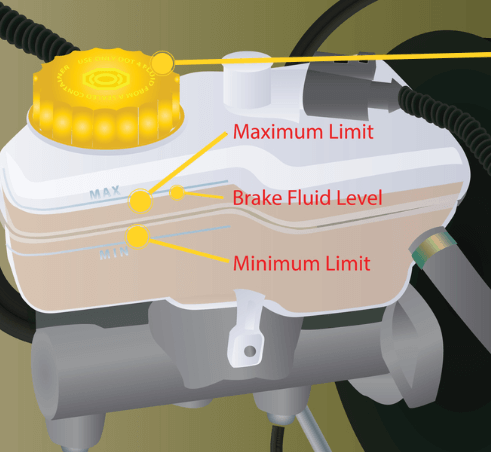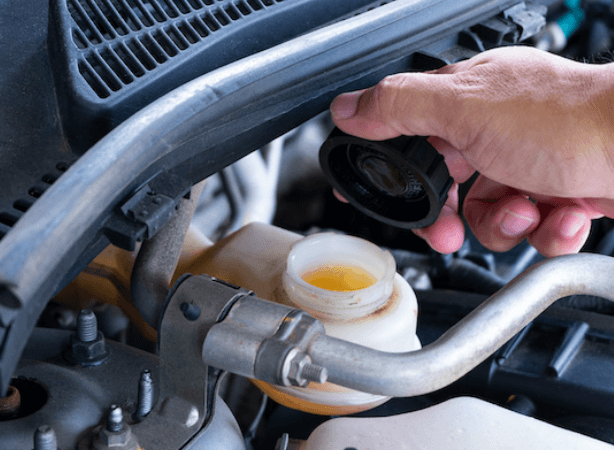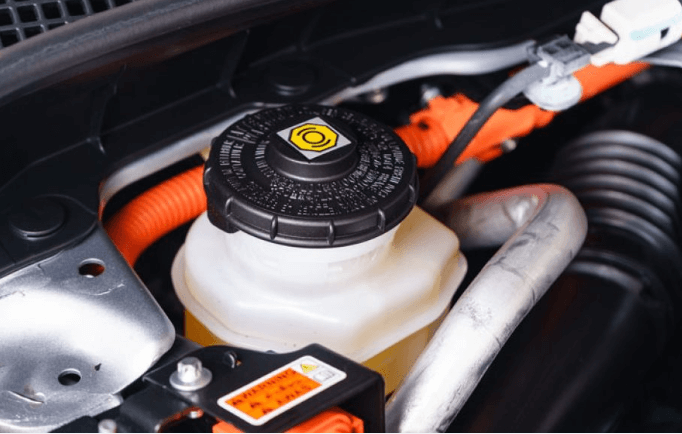When it comes to your vehicle’s safety, brake fluid is a crucial component. It plays a pivotal role in ensuring your car stops when you press the brake pedal. You need to understand what brake fluid is used for, its types, properties, and maintenance as a vehicle owner.
Brake fluid is a type of hydraulic fluid used in hydraulic brake and clutch applications in vehicles. It is responsible for transferring force into pressure and amplifying the braking force. When you press down on your car’s brake pedal, the brake fluid converts this force into pressure, which then applies to the brakes, allowing your car to stop.
In this blog post, I will explain what brake fluid is used for. You will learn its importance in your car and why it must be present in it. I will also discuss the types of brake fluids as well as shed light on what will happen to your vehicle if the brake fluid is low.
If this caught your attention and you want to learn more, join me as I get right into it.
What is brake fluid used for?
Brake fluid is used in hydraulic brakes and clutches for automobiles to transfer force into pressure to bring the vehicle to a stop when the brake is applied. It serves as a lubricant. Brake fluid is used to prevent corrosion and rust. It enhances the durability of the braking system’s movable parts.
Brake fluid is not just another fluid in your vehicle; it’s a lifeline. It ensures that the force you apply to the brake pedal is effectively transmitted to the brake pads or shoes. Without brake fluid, the hydraulic braking system would fail, leading to brake failure. Regular maintenance of brake fluid is, therefore, a critical aspect of vehicle safety, directly impacting your ability to stop your vehicle promptly and safely.

In hydraulic braking systems, brake fluid takes the main stage; it converts the applied force into pressure, effectively stopping your car or motorcycle. It’s used every time a driver brings their car to a stop, making it an indispensable part of the driving experience. This essential fluid isn’t only used in automobiles; it’s a key player in hydraulic brake and hydraulic clutch applications across various vehicles, from cars to motorcycles and light trucks.
Brake fluids are engineered to transfer force into pressure seamlessly. It ensures smooth and responsive braking performance. In addition to its primary role in halting your vehicle, brake fluid also serves as a lubricant for all movable parts, preventing corrosion and rust. this will ensure the safety of your braking system. So, the next time you hit the brakes, remember that it’s not just the pedal; it’s the trusted brake fluid working diligently behind the scenes, used by your vehicle to keep you safe on the road.
Types of brake fluid
You have already learned the magic of brake fluid as the brain behind the smooth and reliable operation of your brakes, enhancing safety on the road. Now let me talk about the various types of brake fluid available on the market. there are several of them:

1. DOT 3 Brake Fluid
One of the most common and widely used types of brake fluid is DOT 3. This fluid is known for its affordability and compatibility with a wide range of vehicles. It has a relatively low boiling point, making it suitable for everyday driving conditions. However, it’s important to note that DOT 3 brake fluid should be replaced more frequently compared to higher-grade options.
2. DOT 4 Brake Fluid
The nest bone is DOT 4 brake fluid. This type offers a higher boiling point than DOT 3, making it suitable for more demanding driving situations. It is often used in performance vehicles or those with heavier loads. The increased boiling point helps prevent brake fluid from vaporizing under extreme conditions, ensuring consistent brake performance.
3. DOT 5 Brake Fluid
Unlike DOT 3 and DOT 4, DOT 5 brake fluid is silicone-based, making it less hygroscopic. This means it absorbs less water, maintaining its properties over a longer period of time. DOT 5 is commonly used in classic cars and motorcycles. However, it’s crucial to note that DOT 5 brake fluid is not compatible with systems designed for DOT 3 and DOT 4.
4. DOT 5.1 Brake Fluid
DOT 5.1 brake fluid shares some similarities with DOT 5 but is glycol-based like DOT 3 and DOT 4. It offers a higher boiling point, providing improved performance under extreme conditions. This makes it a suitable choice for high-performance vehicles and those that undergo rigorous driving conditions.
How Brake Fluid Works
To understand how brake fluid functions within the hydraulic braking system, it’s essential to appreciate its role in vehicle safety.
Hydraulic System Basics
A hydraulic brake system uses brake fluid to transmit pressure from the brake pedal to the brake components at each wheel. When you press the brake pedal, it pushes a piston in the master cylinder, creating pressure in the brake lines filled with brake fluid. This pressure forces the brake calipers or wheel cylinders to press the brake pads or shoes against the rotors or drums, creating friction and stopping the vehicle.
Role of Brake Fluid in Hydraulic Braking
The brake fluid’s primary role is to ensure that the pressure created by the brake pedal is transmitted without loss to the brakes. Its incompressible nature means that it can efficiently transfer force through the brake lines. Additionally, brake fluid must remain stable under various temperatures and pressures to ensure consistent braking performance.
Properties of Brake Fluid
Several key properties make brake fluid suitable for its critical role in vehicle braking systems.
Boiling Point
The boiling point of brake fluid is crucial because the fluid can be subjected to high temperatures due to friction between the brake pads and rotors. If the fluid boils, it can create vapor bubbles that compress, leading to brake failure. Therefore, a high boiling point is essential to prevent this from happening, especially under heavy braking conditions.
Viscosity
Viscosity refers to the thickness of the brake fluid and its ability to flow. Brake fluid needs to maintain a consistent viscosity across a wide temperature range to ensure reliable performance. If the fluid becomes too thick or too thin, it can affect the responsiveness of the braking system.
Hygroscopic Nature
Most brake fluids are hygroscopic, meaning they absorb moisture from the air. This characteristic is both a benefit and a drawback. While it helps prevent water from pooling in the braking system, which could lead to corrosion and brake failure, it also means that brake fluid needs to be changed periodically as it will eventually absorb enough moisture to lower its boiling point and effectiveness.
How do you maintain your brake fluid?
Regular maintenance of brake fluid is essential to ensure optimal braking performance and safety.
Checking Brake Fluid Levels
It’s important to regularly check the brake fluid level in your vehicle’s master cylinder reservoir. Most vehicles have a transparent reservoir with “min” and “max” markings, making it easy to see the fluid level. Ensure the fluid level is within these marks; if it’s low, it may indicate a leak or worn brake components.
How to Top Up Brake Fluid
If your brake fluid is low, you can top it up yourself. First, clean the area around the brake fluid reservoir cap to prevent contamination. Open the cap and add the appropriate type of brake fluid, as specified in your vehicle’s manual. Be careful not to overfill, and avoid spilling the fluid on painted surfaces as it can damage the paint.
When to Change Brake Fluid
You must follow the interval specified by your vehicle manufacturer when it comes to brake fluid changes. It’s typically every 2–3 years. Over time, brake fluid absorbs moisture, which can lower its boiling point and reduce braking efficiency. Regularly changing the fluid ensures that it remains effective and helps prevent corrosion in the braking system.
Signs of Brake Fluid Problems
Being aware of the signs of brake fluid issues can help you address potential problems before they lead to brake failure.
Spongy Brake Pedal
A spongy or soft brake pedal is a common sign of air or moisture in the brake lines. If you notice that your brake pedal is soft when you press it, then it’s important to have your brake system checked immediately, as it can significantly reduce braking effectiveness.
Brake Warning Light
Many modern vehicles have a brake warning light that will illuminate if there is an issue with the brake system, including low brake fluid. If this light comes on, check your brake fluid level and have your vehicle inspected by a professional.
Leaking Brake Fluid
Brake fluid leaks are a serious issue and can lead to brake failure. Signs of a leak include a drop in brake fluid level, visible fluid around the wheels or under the car, and a soft brake pedal. If you suspect a leak, have your vehicle inspected and repaired immediately.
How to Choose the Right Brake Fluid
Selecting the correct brake fluid for your vehicle is crucial for maintaining optimal braking performance.
Go for Manufacturer Specifications
Your vehicle’s manufacturer provides specific recommendations for the type of brake fluid to use. These specifications are based on the design and performance requirements of your vehicle’s braking system. Always refer to your owner’s manual or consult with a professional to ensure you’re using the correct fluid.
Matching Brake Fluid to Vehicle Requirements
Different vehicles have different braking system requirements. High-performance or heavy-duty vehicles may require brake fluid with a higher boiling point, such as DOT 4 or DOT 5.1. Understanding your vehicle’s needs and using the appropriate brake fluid will ensure optimal performance and safety.
Read this also: How long does brake fluid last?

Brake fluid is a critical component of your vehicle’s braking system, playing a vital role in ensuring safe and effective braking. Regular maintenance, including checking levels and changing the fluid as needed, is essential for optimal performance. By understanding the different types of brake fluid and their properties, you can make informed choices and ensure your vehicle remains safe on the road. Remember, keeping your brake fluid in good condition is not just about maintaining your car; it’s about ensuring your safety and the safety of others.
Frequently Asked Questions (FAQ)
- How Often Should I Change My Brake Fluid?
Brake fluid should typically be changed every 2–3 years, but it’s best to follow your vehicle’s manufacturer’s recommendations. Regular changes help maintain the fluid’s effectiveness and prevent moisture buildup.
- 2. Can I mix different types of brake fluid?
It’s generally not recommended to mix different types of brake fluid, especially glycol-based and silicone-based fluids. Mixing can lead to chemical reactions that reduce the effectiveness of the fluid and potentially damage the braking system.
- 3. What should I do if my brake fluid is low?
If your brake fluid is low, check for leaks and top up with the appropriate type of brake fluid. If the level continues to drop or if you experience braking issues, have your vehicle inspected by a professional.
This post has painstakingly explained what brake fluid is used for, brake fluid types, and the consequences of low brake fluid in a car. The information is aimed at guiding you to make an informed decision about the well-being of your car.
Feel free to engage with the blog and drop your comment in the comment section below for any questions or suggestions.

With Over 7 years of experience dealing with car owners as a car lease agent, I have gained matchless car knowledge to help every car owner know what exactly is wrong with their cars.


